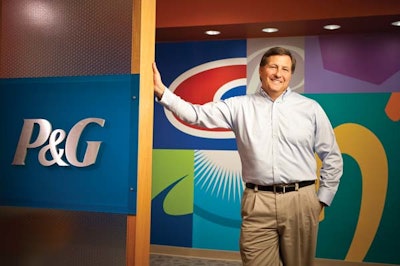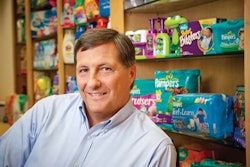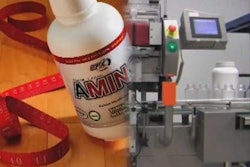
We can reach a state where the use of sustainable packaging is the rule rather than the exception if we focus on a handful of major challenges. That’s the opinion of Tony Burns, associate director, sustainability, for P&G’s Global Package and Device Development (GPDD) group. Burns is responsible for developing global packaging sustainability for the Cincinnati-based consumer packaged goods (CPG) powerhouse.
Burns believes that four major, game-changing challenges exist in the drive to package sustainability:
Supply chain reinvention. “We know that our existing supply chains put performance burdens on our packages that limit our ability to reduce material use,” says Burns. “This is a long-term goal and will require industry-wide leadership and collaboration, but there are huge benefits if we can reduce the forces on our packages throughout the supply chain.”
Recycling. “We need to increase reach and rate,” he says. “It’s plain and simple—we are throwing valuable resources into landfills that should be recycled. We need to change consumers’ mindsets and improve infrastructures to efficiently collect, separate, and sort materials in order to drive recycling. This is especially true in the United States.”
New materials. “New classes of materials are being developed as we speak. These materials offer the ability to significantly reduce the environmental impact of our packaging and also potentially reduce our dependence on sourcing petroleum-derived materials. They will not be ‘the’ solution, but will be an important tool in our packaging engineers’ and designers’ toolbox,” he says.
Industry standards for metrics and measures. “We absolutely need to drive to standardization in our metrics and measures as an industry or we will spend all of our time administering data instead of innovating,” says Burns.
Experience affords P&G a platform
It’s not merely the company’s sheer size and product reach that lend P&G a credible voice in sustainability, but its experience in delivering environmentally thoughtful packaged goods to the commercial market. In November 2008, P&G released its 10th Annual Sustainability Report (see sidebar, page 56). “We’ve worked on package sizing issues, lightweighting, and cost savings pertaining to packaging across all of our businesses for many years. Reducing our environmental impact is not new,” Burns says. “Now our sustainability efforts seek to consolidate into a standard approach across all of our diverse businesses and products.” That includes everything from research and development and innovation to working with suppliers to resource consumption at P&G facilities.
“Sustainability is at the core of everything we do in all of our business units; our sustainability focus is not just in packaging, but focuses throughout the entire product/packaging development area.” Burns says that it’s important to keep in mind that “packaging is a small part of the overall environmental footprint of a product. So why is there such a focus on packaging in the consumer goods area?
At times it does feel like packaging is becoming ‘the villain,’ when in reality it is a small player in the overall environmental footprint of the product. However, viewed through the lens of our consumers, packaging is the first thing and also the last thing that they experience with our brands. Therefore if it is important to our consumers, then it is important to us.”
P&G refers to consumers as “the boss,” so it makes sense that consumers push P&G’s sustainability efforts. “We want to make sure that packaging is thought of holistically with the product so that it delivers that product in its intended state through the supply chain to the consumer, serving its purpose from the standpoint of consumer usage all the way through disposal,” Burns says. “We have to begin with the basic premise that the product and package meet the needs of the consumers in the most sustainable manner possible, realizing early on in the development process that these decisions carry significant impact.”
Toward that end, the company has appointed sustainability experts—and in some areas teams of experts—on nearly all of its leading brands. Some brands have dedicated packaging engineers leading their sustainability efforts. In one example, packaging engineers redesigned the plastic bottles for Pantene Pro-V, reducing both package weight and material usage without any noticeable change for the consumer. Engineers project to save more than 450 metric tons of plastic per year—equal to more than 13 million Pantene Pro-V bottles. Another change to the pump dispenser in the Olay Total Effects bottle is expected to reduce 800,000 lb of plastic a year—equal to the weight of a Boeing 747.
“About 80 percent of our consumers tell us that environmental sustainability is important. That itself is reason for us to engage in this and to meet the needs of the consumers. They may not pay additional money right now for more sustainable packaging, but it’s important to them. Whatever benefits they are buying our brands for, we want to make sure that we package that in the most sustainable fashion possible,” says Burns.
A good example of listening to consumers is the new pack for the company’s Prilosec OTC heartburn treatment where two inner blister packs containing seven tablets each were replaced by one pack of 14, in virtually the same blister footprint (for the complete story, see the January/February issue of Healthcare Packaging magazine). This made usage easier for the consumer, while saving more than 500,000 lb of packaging material each year.
Key role for both materials and machinery
Satisfying consumers is key to any business, but the role of sustainable packaging is vital to P&G’s bottom line. P&G calls this sustainable sustainability—ensuring that any changes made in the name of sustainability also are viable long-term solutions to the company. It is indeed, a delicate balance, Burns acknowledges. But it’s one that P&G is managing with some solid wins.
For example, Gillette changed its packaging of blades and razors sold in the North American Club Store Channel that resulted in larger, more visually appealing packaging for consumers but uses 70 percent less plastic and is 10 percent lighter. “More sustainable does not necessarily mean smaller and less visual,” Burns says. The design is now being reapplied to all Gillette products.
Part of Burns’s role is to help communicate successes such as the Gillette example across the company, so P&G’s other 300 brands might reapply. “Communication across a business with so many diverse categories has indeed proved challenging,” Burns admits. But with a network of sustainability experts now in place across the brands, Burns says communications are flowing faster and more effectively. Plus, all are working toward a commonly established goal.
“Packaging considerations are an integral part of our corporate goal of developing $20 billion in sustainable innovation products.” Referred to internally as SIPs, these are products that leave an environmental footprint at least 10 percent smaller than their predecessors. To qualify, products must meet a rigorous and detailed set of standards established by the P&G sustainability team. This reduction can be in any phase of the product’s life cycle, and thus includes packaging.
“The more challenging piece of our effort is establishing common frameworks and metrics to measure and track performance so that we can approach specific sustainability challenges from a common understanding.”
Burns adds, “We have also spent time sharing and discussing our specific needs and expectations with our external supply partners to make sure we’re all working under a common understanding.”
He credits packaging materials suppliers in supporting P&G’s sustainable packaging journey. “We could not have progressed without our suppliers, as they have been critical to our success. From the beginning, we engaged our lead global suppliers, discussed how we were planning to address the issue and asked for their help in driving our short- and long-term progress. Sustainability is discussed in all of our technology reviews with core suppliers.”
Most sustainable packaging efforts understandably focus on materials, but Burns also notes, “Machinery plays a critical role in driving sustainable packaging. In fact, I believe that packaging equipment throughout the supply chain will become one of the critical areas where we will require innovation from the industry. Why? The industry has been optimizing materials and package designs for decades. What we are finding is that we are now approaching the limits of supply chain transformations and will require innovation to remove these barriers and develop materials and package design solutions that meet our long-term goals.” He believes, “Machinery design and process optimization, in concert with modeling and simulation, will be required to efficiently create tomorrow’s sustainable packaging solutions.”
Walmart’s scorecard impact
How has the Walmart scorecard changed P&G’s sustainability efforts? Burns tells Packaging World, “The Walmart packaging scorecard has been one of the broadest industry projects, tackling one of the most difficult problems that I have ever experienced. Their ability to bring such a wide breadth of perspectives and technical expertise to the table from NGOs, GOs, academia, suppliers and CPG (consumer packaged goods) companies really has been amazing. We are fully supportive of Walmart’s direction to remove non-value added packaging from the supply chain while upholding their commitment to not accepting performance trade-offs. The bottom line is that if you focus on improving your designs and consider the nine metrics in the scorecard, you will improve the environmental sustainability of your package.”
Does Walmart’s RFID mandate ever conflict with efforts to accommodate the sustainable packaging scorecard? “To date,” says Burns, “the discussions on RFID really haven’t posed a significant challenge from a sustainability standpoint. Whatever we decide is required to meet these RFID needs, we must do it in the most sustainable fashion possible.”
Burns summarizes P&G’s bottom line regarding the Walmart scorecard: “Walmart is a key customer to Procter and Gamble. Therefore, it is important to us to make sure that we try to help them meet their sustainability goals as well. We try to meet their needs while staying focused on making sure our products and brands delight the consumer, who is really our boss.”
Goal-based effort
Burns says P&G’s sustainability successes to date stem from corporate strategies and setting goals. “We don’t think of products and packages differently from the environmental sustainability standpoint. Instead, we look at the entire life cycle of the product and apply sustainable thinking to each and every phase.”
Taking this holistic view, P&G immediately saw the potential for tremendous savings in the production phase of the product’s life cycle. Around the world, teams have been challenged to reduce the environmental footprint of P&G’s plants, with creative and high-impact results. Globally, P&G has cut water usage by 51 percent since 2002, waste disposal by 50 percent, CO2 emissions by 52 percent, and energy usage by 46 percent.
“The next big goal that we set is from our operational standpoint. Our operations have done a good job of reducing their environmental footprints over the past decade. We have already achieved a 30-percent reduction on our overall environmental footprint from manufacturing, and we have set a goal of a further 10-percent reduction over the next five years.”
Burns highlights one sustainable packaging example that had a resounding ripple effect across the entire production phase, and around the product’s entire life cycle. “Compacting our liquid laundry detergents in the U.S. is a really good example of how we’re proactive in our operations in reducing our environmental footprint. For example, we recently launched into the U.S. new liquid laundry detergents under our Tide and Gain brands that are 2X concentrations of our products. In essence, what we have been able to do is deliver the same or better product performance with the consumer only having to use half as much product. That has a ripple effect in that it allows us to reduce the size of the bottle, the closure, and the amount of corrugated, pallets, stretch wrap, and number of trucks.”
This change saves each year more than 500 million litres of water, 100,000 metric tons of C02, 40,000 truck shipments, and 15,000 metric tons of packaging materials.
Virtually all of these source-reduction efforts have an impact on packaging lines and energy usage within P&G facilities. “When we compacted our laundry detergents it necessitated a complete overhaul of our packaging supply chain. So while there was a significant corporate investment, we tried to use those investments in the most sustainable fashion possible.”
The three ‘Rs’
Burns says there is little debate about which of the three “R’s,” reduce, reuse, and recycle, is the best to follow. “The one thing that always comes to the top is that a reduction of materials is generally a good thing from a packaging sustainability standpoint, assuming you can get the same performance with the reduced amount of materials. We are looking at it holistically. We want to look at innovation to reduce not just packing materials, but also energy, water, trans- portation, and replacing the use of non-renewable energy materials with renewable sources. If you look at the total lifecycle approach of a product in the corresponding analogy to packaging, it’s very complex and we want to make sure we achieve a meaningful reduction in this important environmentally sustainable area, but without any tradeoffs in any other areas that sometimes can arise.”
Burns stresses that at P&G, sustainability extends beyond environmental responsibility, but also includes social responsibility. P&G developed Live, Learn and Thrive™, its corporate social sustainability programs that includes a series of programs aimed at supporting the development of children in need around the world. Live, Learn and Thrive includes programs “such as our pure safe drinking water initiative that was recently recognized as one of the top 10 breakthroughs to change the world by Popular Mechanics magazine,” he explains. “We have our Pampers program where we partnered with UNICEF to already deliver more than 50 million Tetanus shots to neonatal care in developing regions. So there are a number of social elements that we have within the broader scope of sustainability that packaging wouldn’t be considered part of, yet they are a meaningful part of our overall corporate sustainability program.”
Burns says P&G’s entire global sustainability efforts hinge on adhering to a philosophy: “We do not believe that there needs to be a trade-off between performance, value, and incorporating sustainability considerations into our packaging programs. As a result, we are viewing decisions through our sustainability lens at the front end of all projects. We don’t believe we can focus too early on delivering the most sustainable packaging possible, from our packaging suppliers to our operations, and most of all, for our consumers.”






















